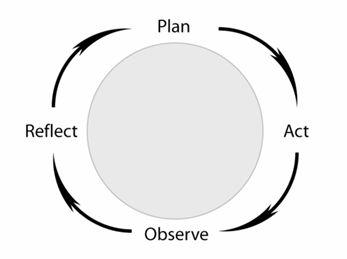Applying Creatively

Action Research
Research is about finding out. Mostly its outcomes are just knowledge, but there is no need to act on this knowledge. Action research is research that considers action and research, which informs action. It is about thinking and doing. Action research involves the following cycle:

Decision Making Strategy
- Describe the decision that needs to be made the dilemma that underlies it.
- Outline alternative approaches.
- List criteria for that would represent positive outcomes of the decision and rank these.
- Enact the decision.
- Evaluate on the decision in relation to intended outcomes.
A Decision- Making Matrix
|
Criteria |
Choice 1 |
Choice 2 |
Choice 3 |
Invention
- Describe the goal or purposes of the invention.
- Outline alternative approaches in plans or models.
- Build a prototype.
- Test the prototype; measure its effectiveness in relation to the initial goals and purposes of the invention.
- Write an evaluation report which tells the story of the invention and assesses its effectiveness.
Kinaesthesia
Learners transfer meanings from one mode to another (such as from visual to linguistic or from linguistic to gestural), or from one medium to another, such as story to video. Or they transfer a set of meanings from one, familiar setting to another, less familiar setting, adjusting the mode and the medium to suit.
Knowledge Transfer
Use the knowledge you have acquired (new experiences, concepts, theories, analyses, appropriate applications) and apply this in a different setting, to a different subject matter or to a different problem. Reflect on the similarities and differences between the original and the new context.
Literacy Applications: Productive Activities
Learners write mixing genres, creating an original, hybrid work.
Multiliteracies Applications: Productive Activities
Learners create a multimodal text which mixes modes of meaning (linguistic, visual, gestural, audio and spatial), media and genres in an original or hybrid way.
Personal Action Plan
Turn an idea into action.
- My goal.
- My commitment: what I will need to do to meet my goal.
- Action step 1
- Action step 2 … etc.
- The resources and support I will need.
- Possible barriers: things that might help me reach my goal.
- Performance measures: how I will know I have met my goal; what I will have achieved,
Problem Defining
In the ‘Applying Appropriately’ section, we discussed problem solving technique. Even harder is to define what the problem is. Take a situation, and discuss the key problems that require a solution.
